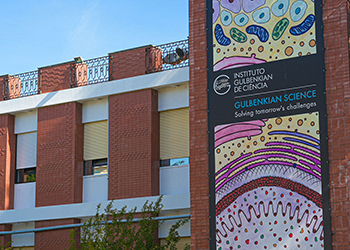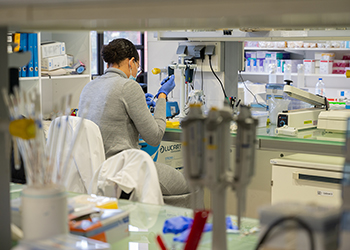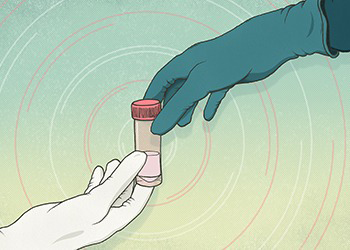
Cell Biology of Viral Infection
Maria João Amorim
Influenza A virus is one of the major causes of acute contagious respiratory disease in humans, leading to seasonal epidemics and sporadic deadly pandemics.
Despite tight surveillance of circulating strains worldwide, and the implementation of yearly vaccination schemes, the pathogen is responsible for high mortality, morbidity and economic damage. Development of novel ways to control infection is therefore necessary. The elucidation of host factors contributing to a productive infection, as well as host pathways that are able to regulate it can lead to novel therapies.
The Cell Biology of Viral Infection Lab is interested in understanding the interactions between influenza A virus and the infected host at different levels. By identifying the host machinery necessary to sustain viral infection we seek to understand the viral lifecycle and unravel key aspects of the biology of the cell.
Our goal is to explain if the viral usage of a certain pathway induces alterations to its normal functioning and to the overall morphology of the cell. By studying the host response to viral challenge, we seek to unravel host innate immune responses and ways to control viral infection.
Funding

![]()
Projects
Influenza A virus constitutes a serious health problem being responsible for a quarter to half a million deaths annually, depending on the pathogenicity of the circulating strain, prior immunity, and effectiveness of the administered vaccine.
Pathogenesis determinants include the intrinsic properties of IAV strains, and their interplay with host defence mechanisms. The Amorim lab found a specific interaction between influenza A virus and the complement system. With renewed interest caused by implementation of successful complement-targeting therapies, the complement is not just a pathogen killer, but a key player in immunity. It bridges innate and adaptive responses, and orchestrates the intensity of immunological and inflammatory processes by communicating with immune cells. Interactions are beginning to be fully appreciated, and their identification is crucial, as excess complement activation is associated with severe outcomes in many infections. In addition, the complement must be selective enough to avoid mounting a potent attack against the host. The self-targeting deleterious effects of complement are avoided via a series of so called regulators of complement activation (RCA). Our goal is to understand the role of these RCAs in influenza A virus infection, contributing to better define how complement communicates with other biological systems.
Mitochondria were originally described as the powerhouse of the cell, but their importance expanded as their role in controlling death processes was discovered.
More recently, these organelles also emerged as central players in innate immune processes, in particular interferon responses, which constitute the first line of defense against viruses. It is therefore not surprising that viruses interfere with mitochondrial pathways. Mitochondria functions are intimately related to dynamic changes in their morphology and distribution within the cell. Therefore, the characterization of these two parameters during influenza A virus infection is being investigated as well as the cellular processes leading to identified alterations. In addition, the Amorim lab found an interaction between mitochondria, the recycling endosome and influenza A virus that is currently being investigated.
Viral assembly is a fascinating molecular biology process. Once a virus enters a cell and replicates, it needs to form new virions that are composed of viral genome and specific proteins. These components, synthesized in distinct cellular organelles, are therefore required to meet at specific cellular locations to form a supra-molecular complex. In the case of influenza A virus this process is particularly challenging because the viral genome is segmented, formed by eight independent RNA units. The formation of the genomic complex and the biological processes facilitating the assembly of viral genome are ill-defined. Formation of IAV genomic complex is a complex selective process, as virions do not usually package more than eight segments and each segment generally occurs once per virion. Although it is well established that viral assembly takes place at the plasma membrane, it is still unclear where the genomic complex is formed. Recently, we demonstrated that influenza A virus (IAV) establishes viral inclusions that favor infection. We propose that viral inclusions constitute dedicated sites for the assembly of influenza genomes. Two interesting concepts have arisen from our work:
- viral inclusions have liquid properties;
- there is a close association between viral inclusions and the endoplasmic reticulum.
The lab is currently investigating these topics and exploring their potential as antiviral targets.
Publications
- Temitope Akhigbe Etibor, Silvia Vale-Costa, Sindhuja Sridharan, Daniela Brás, Isabelle Becher, Victor Hugo Mello, Filipe Ferreira, Marta Alenquer, Mikhail M Savitski and Maria-João Amorim (2023) Defining basic rules for hardening influenza A virus liquid condensates. eLife 12:e85182
- Alenquer M, Ferreira F, Lousa D, Valério M, Medina-Lopes M, Bergman M-L, et al. (2021) Signatures in SARS-CoV-2 spike protein conferring escape to neutralizing antibodies. PLoS Pathog 17(8):e1009772
- Santos NB, Vaz da Silva ZE, Gomes C, Reis CA, Amorim MJ (2021) Complement Decay-Accelerating Factor is a modulator of influenza A virus lung immunopathology. PLoS Pathog 17(7):e1009381
- Ho, J S Y, Angel, M, Ma, Y, Sloan, E, Wang, G, Martinez-Romero, C, Alenquer, M, Roudko, V, Chung, L, Zheng, S, Chang, M, Fstkchyan, Y, Clohisey, S, Dinan, A M, Gibbs, J, Gifford, R, Shen, R, Gu, Q, Irigoyen, N, Campisi, L, Huang, C, Zhao, N, Jones, J D, van Knippenberg, I, Zhu, Z, Moshkina, N, Meyer, L, Noel, J, Peralta, Z, Rezelj, V, Kaake, R, Rosenberg, B, Wang, B, Wei, J, Paessler, S, Wise, H M, Johnson, J, Vannini, A, Amorim, M J, Baillie, J K, Miraldi, E R, Benner, C, Brierley, I, Digard, P, Łuksza, M, Firth, A E, Krogan, N, Greenbaum, B D, MacLeod, M K, van Bakel, H, Garcìa-Sastre, A, Yewdell, J W, Hutchinson, E, Marazzi, I, (2020) Hybrid Gene Origination Creates Human-Virus Chimeric Proteins during Infection. Cell 181: 1502–1517
- Alenquer M, Vale-Costa S, Sousa AL, Etibor TA, Ferreira F and Amorim MJ (2019) Influenza A virus ribonucleoproteins form liquid organelles at endoplasmic reticulum exit sites. Nature Communications 10, Article number: 1629. Top 2% in Biochemistry, Genetics and Molecular Biology.
- Nieto A, Vasilijevic J, Santos NB, Zamarreño N, Amorim MJ, Falcon A (2019) Mutation S110L of H1N1 influenza virus hemagglutinin: A potent determinant of attenuation in the mouse model. Front. Immunol 10, Article 132. Top 12% in Immunology.
- Amorim MJ (2019) A comprehensive review on the interaction between the host GTPase Rab11 and influenza A virus. Frontiers in Cell and Developmental Biology 6 Article 176. Top 13% in Cell Biology
- Pereira CF, Wise HM, Kurian D, Pinto RM, Amorim MJ, Gill AC, Digard P (2018) Pleotropic effects of mutations in the effector domain of influenza A virus NS1 protein. BMC Research Notes BMC Research notes, 11:673.
- Ramos-Nascimento A, Kellen B, Ferreira F, Alenquer M, Vale-Costa S, , Raposo G, Delevoye C and Amorim MJ (2017) KIF13A mediates influenza A virus ribonucleoproteins trafficking. Journal of Cell Science 130:4038-4050. Top 12% in Cell Biology.
- Pereira, C.F., Read, E.K.C., Wise, H.M., Amorim, M.J., Digard, P. (2017) The influenza A virus NS1 protein promotes efficient nuclear export of unspliced viral M1 mRNA.. J Virol. 91(15):e00528-17
- Sousa, A.L., Vale-Costa, S., Amorim, M.J., Tranfield, E.M. (2017) Using correlative light and electron microscopy to understand influenza A viral assembly.. Ultrastruct Pathol. 41(1):80-81
- Vale-Costa, S., Amorim, M.J. (2016) Clustering Rab11 vesicles in influenza A virus infected cells creates hotspots containing the 8 viral ribonucleoproteins.. Small GTPases. 8(2):71-77
- Vale-Costa, S., Alenquer, M., Sousa, A.L., Kellen, B., Ramalho, J., Tranfield, E.M., Amorim, M.J. (2016) Influenza A virus ribonucleoproteins modulate host recycling by competing with Rab11 effectors.. J Cell Sci. 129(8):1697-1710
- Vale-Costa, S., Amorim, M.J. (2016) Recycling endosomes and viral Infection.. Viruses 8(3):64-92
- Alenquer M., Amorim, M.J. (2015) Exosome biogenesis, regulation, and function in viral infection.. Viruses 7(9):5066-5083
- Amorim, M.J.* , Kao, R., Digard P. (2013) Nucleozin targets cytoplasmic trafficking of viral ribonucleoprotein-Rab11 complexes in influenza A virus infection.. J Virol. 87(8):4694-4703
- Amorim, M.J. ‡, Bruce, E.A.‡, Read, E.K., Foeglein, A., Mahen, R., Stuart, A.D., Digard, P. (2011) A Rab11-and Microtubule-Dependent Mechanism for Cytoplasmic Transport of Influenza A Virus Viral RNA.. J Virol. 85(9):4143-4156
- Amorim, M.J., Mata, J. (2010) Global coordination of transcriptional control and mRNA decay during cellular differentiation.. Mol Syst Biol. 6(380):1-11
- Amorim, M.J., Mata, J. (2009) Rng3, a member of the UCS family of myosin co-chaperones, associates with myosin heavy chains cotranslationally.. EMBO Rep. 10(2):186-191



